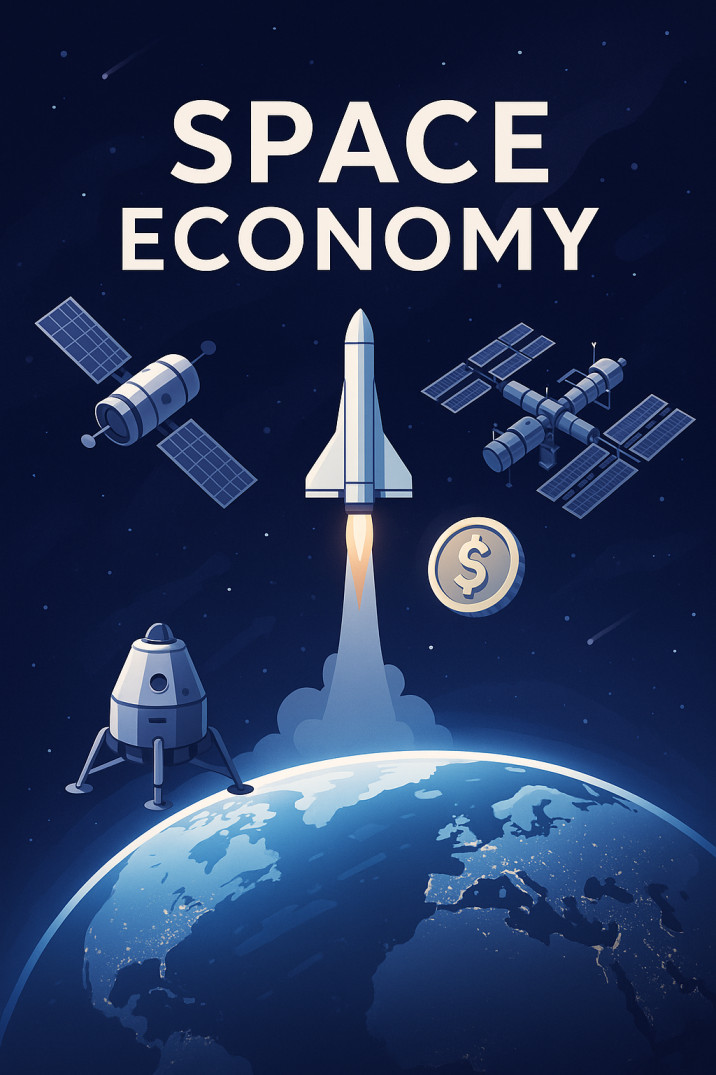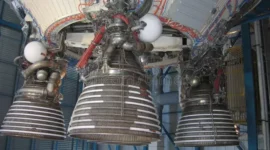The space economy is no longer a futuristic concept but a rapidly expanding and increasingly vital sector of the global economy. Once dominated by government-funded agencies and a handful of large aerospace contractors, it has undergone a dramatic transformation, driven by technological advancements, declining costs, and the growing involvement of private enterprises. This essay will delve into the present status of the space economy, highlighting its key components, major players, and economic impact, before exploring its promising future, including emerging sectors, potential challenges, and the transformative implications for humanity.
Present Status of the Space Economy
The global space economy is currently a robust and expanding domain, encompassing a wide array of activities, from satellite manufacturing and launch services to satellite-derived applications and burgeoning in-space ventures. GlobalData estimates the market to be around $421 billion in 2024, with projections to surpass $511 billion by 2029. Other estimates are even more optimistic, with McKinsey & Company projecting the space economy to reach an astounding $1.8 trillion by 2035, and Morgan Stanley predicting a $1 trillion market by 2040. This growth is fueled by several factors, including the increasing deployment of Low Earth Orbit (LEO) satellites, improvements in satellite equipment manufacturing, and the emergence of non-Western companies as significant players.
Satellite applications form the largest segment of the space economy, including satellite communications, navigation (GPS), and Earth observation. These applications are deeply integrated into daily life and various industries, offering services that range from enhanced broadband connectivity in remote areas to precise agricultural monitoring, disaster management, urban planning, and environmental tracking. For instance, satellite broadband is closing the gap in terrestrial infrastructure, allowing developing nations to attract more foreign direct investment and accelerate digitalization. Advanced technologies like spaceborne synthetic aperture radar (SAR) for detailed mapping, satellite-to-ground optical (laser) technology for ultra-high-speed data transmission, and 5G Non-Terrestrial Network (NTN) are further enhancing remote sensing and communication capabilities.
The launch services sector has witnessed a revolutionary shift with the advent of reusable rocket technology, pioneered by companies like SpaceX. The cost of launching payloads to orbit has plummeted dramatically, from around $18,500 per kg during the Space Shuttle era to approximately $1,500 per kg with the Falcon 9, with Starship aiming for an ambitious $100 per kg. This reduction in launch costs is arguably the single most important trend in commercial spaceflight, making space access more affordable and frequent. It has democratized space, allowing smaller startups, research institutions, and even individuals to consider developing and testing technologies in orbit, thereby fostering unprecedented innovation.
Government agencies continue to be significant drivers of the space economy, with substantial budgets allocated to research, exploration, and national security. NASA, for example, has a budget of approximately $25.4 billion for 2024, funding ambitious projects like the Artemis program to return humans to the Moon, which is projected to cost $93 billion by 2025. Other major space agencies include the European Space Agency (ESA), China National Space Administration (CNSA), Indian Space Research Organisation (ISRO), and Japan Aerospace Exploration Agency (JAXA), all of whom contribute to technological advancements and scientific understanding while often collaborating with private industry. These government investments act as a crucial foundation, de-risking new technologies and creating opportunities for private sector participation through contracts and partnerships.
Private investment in the space industry has surged, with venture capital firms playing a substantial role. By 2021, total private investment in the space industry reached $46.5 billion, with $27.1 billion from venture capital. This influx of private capital is a testament to the growing confidence in the commercial viability of space ventures. Major private players like SpaceX, Blue Origin, and Rocket Lab are not only revolutionizing launch but also developing satellite constellations, in-orbit services, and even plans for human spaceflight. Established aerospace giants like Lockheed Martin also maintain a strong presence, often collaborating with new entrants or consolidating to remain competitive.
The space economy’s impact extends far beyond the aerospace industry itself. It generates significant economic benefits on Earth, including job creation, revenue generation, and cost reductions through spin-off technologies. Satellite data and services are improving efficiency and resilience in diverse sectors like logistics (monitoring cargo ships), energy (detecting methane leaks), and agriculture (monitoring crop health and managing invasive species). The Indian space sector, for instance, generated USD 60 billion for the national economy and created 4.7 million jobs between 2014 and 2024, with ISRO’s satellites benefiting millions of people through improved weather forecasts and agricultural insights.
However, the present landscape is not without its challenges. Regulatory issues can pose hurdles, and the financial viability of young satellite and rocket companies can be uncertain, especially given the current global economic environment. Orbital debris is another pressing concern, with estimated annual losses from satellite collisions ranging from $86-103 million in 2020, primarily in LEO. Addressing this issue, which suffers from a “free-rider problem” where individual operators do not sufficiently internalize the cost of their debris, will require innovative policy and technological solutions.
Future of the Space Economy (Next 30 Years)
Looking ahead over the next 30 years, the space economy is poised for exponential growth and diversification, driven by continued technological innovation, the maturation of nascent sectors, and increasing global participation. The projected market size reaching $1 trillion by 2040 and $1.8 trillion by 2035 underscores the immense potential.
One of the most transformative trends will be the continued democratization of space access. As reusable rocket technology becomes more commonplace and new launch providers emerge, launch costs will continue to decrease, making space accessible for a wider range of commercial and scientific endeavors. This will accelerate the deployment of large satellite constellations for global internet coverage (e.g., Starlink, Amazon Kuiper), leading to a truly interconnected world. The proliferation of small satellites will enable highly specialized and cost-effective services across various industries.
In-space manufacturing and assembly (ISM) represent a revolutionary frontier. Producing materials and components directly in space offers significant advantages, including reduced launch mass, minimized waste, and the ability to create structures not feasible on Earth due. ISM could enable on-demand fabrication, repair, and recycling of components, supporting sustainable exploration and reducing reliance on Earth-based supply chains. Future advancements could include 3D-printed repairs, large-scale antenna construction, and even the in-situ production of food and pharmaceuticals for long-duration missions. The integration of In-Space Resource Utilization (ISRU), leveraging lunar regolith and asteroids for water, metals, and oxygen, will be crucial for sustainable space operations, significantly reducing the cost of deep space missions. NASA’s Artemis program, targeting human exploration of the Moon, is a testament to this vision, laying the groundwork for further exploration and utilization of lunar resources.
The lunar economy is expected to blossom, driven by renewed interest in Moon exploration and the potential for lunar resource utilization. Missions like Firefly Aerospace’s Blue Ghost and ispace’s Resilience are demonstrating the strength of commercial partnerships in advancing lunar exploration. The Moon could become a hub for scientific research, resource extraction (particularly water ice for propellant), and potentially a stepping stone for deeper space exploration. The economic impact of lunar mining could be significant, offering valuable resources and fostering new industries.
Space tourism is rapidly becoming a reality, though its significant contribution to the overall space economy is expected to materialize more fully after 2030. Companies like Blue Origin and Virgin Galactic are offering suborbital flights, and further advancements are expected to make orbital and even lunar tourism accessible to a niche, high-net-worth market. The space tourism market was valued at USD 1.26 billion in 2025 and is expected to reach USD 2.74 billion by 2030, with continued growth projected thereafter. This sector will not only generate revenue but also inspire a new generation and push technological boundaries for human spaceflight.
Asteroid mining holds immense long-term potential. Asteroids contain vast quantities of valuable minerals like platinum, cobalt, iridium, and iron, which are scarce on Earth. While still in its early stages, with the Psyche orbiter launched in 2023 to reach asteroid 16 Psyche by 2029, the economic feasibility is being actively explored. Some estimates suggest a single asteroid could contain billions or even trillions of dollars worth of metals. Successful asteroid mining could fundamentally reshape global supply chains, lower prices for rare minerals, and create entirely new industries on Earth and in space. Robotics will play a crucial role in navigating and extracting these resources.
The vision of Mars colonization remains a long-term aspiration, with its economic feasibility tied to the development of robust in-situ resource utilization and self-sustaining capabilities. While a full self-sufficient society on Mars is a distant prospect, the initial phases of pre-settlement outposts will be driven by continued reductions in launch costs, potentially by Starship, and the ability to extract local resources like water and construction materials. The economic drivers for Mars would include local resource development and, in the very long term, potential trade with Earth and the asteroid belt.
Beyond these direct applications, the space economy will increasingly focus on space sustainability and orbital debris management. As more satellites are launched, the risk of collisions and the accumulation of debris become critical concerns. Technologies for active debris removal, in-orbit servicing, and more resilient satellite designs will become essential services within the space economy, driven by both regulatory pressures and economic necessity to protect valuable space assets.
International cooperation will continue to be a cornerstone of space exploration and economic development. Organizations like ISRO are actively pursuing bilateral and multilateral relationships with other space agencies to share expertise, undertake scientific and technological challenges, and define international frameworks for space utilization. This collaboration is crucial for addressing global challenges, such as climate change, and for ensuring the peaceful and sustainable use of outer space.
Finally, the future space economy will be heavily influenced by advancements in artificial intelligence (AI) and automation. AI will be vital for managing complex satellite constellations, optimizing launch trajectories, processing vast amounts of satellite data, and enabling autonomous operations for in-space manufacturing and resource extraction. The integration of AI will enhance efficiency, reduce human intervention, and unlock new possibilities across all sectors of the space economy.
In conclusion, the space economy is experiencing a golden age of growth and innovation. From its origins as a government-led endeavor, it has rapidly evolved into a dynamic ecosystem where private enterprises play an increasingly pivotal role. The present status is characterized by a thriving satellite applications market, revolutionary reductions in launch costs, and significant private investment. Looking ahead, the next 30 years promise an even more transformative era, with the maturation of in-space manufacturing, the establishment of a lunar economy, the burgeoning of space tourism, and the long-term potential of asteroid mining and even Mars colonization. While challenges such as orbital debris and regulatory complexities persist, the inherent opportunities for technological advancement, economic growth, and global collaboration ensure that the space economy will remain a critical frontier, profoundly impacting life on Earth and beyond.




